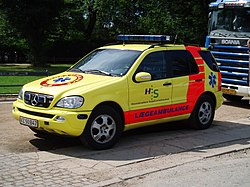Emergency physician: Difference between revisions
No edit summary |
Rescuing 2 sources and tagging 0 as dead. #IABot (v1.5.2) |
||
| Line 15: | Line 15: | ||
An '''emergency physician''' is a [[physician]] who works at an [[emergency department]] to care for acutely ill patients. The emergency physician is a specialist in [[advanced cardiac life support]] ([[advanced life support]] in Europe), [[resuscitation]], [[physical trauma| trauma]] care such as [[fracture]]s and [[soft tissue injury|soft tissue injuries]], and management of other life-threatening situations. |
An '''emergency physician''' is a [[physician]] who works at an [[emergency department]] to care for acutely ill patients. The emergency physician is a specialist in [[advanced cardiac life support]] ([[advanced life support]] in Europe), [[resuscitation]], [[physical trauma| trauma]] care such as [[fracture]]s and [[soft tissue injury|soft tissue injuries]], and management of other life-threatening situations. |
||
In some [[Europe]]an countries (e.g. [[Germany]], [[Belgium]], [[Poland]], [[Austria]] and [[Denmark]]), emergency physicians/anaesthetists<ref>{{cite web|url=http://www.ibtphem.org.uk/IBTPHEM/Training.html |title=Training |publisher=Ibtphem.org.uk |date= |accessdate=2014-04-11}}</ref> are also part of the emergency medical service and are dispatched together with [[emergency medical technician|EMT]]s and [[paramedics]] in cases of potentially life-threatening situations for patients (heart attacks, serious accidents, resuscitations or unconsciousness, strokes, drug overdoses, etc.). An emergency physician is a "Jack of all trades". In the United States, emergency physicians are mostly hospital-based, but they often work on [[air ambulance]]s and mobile intensive-care units. |
In some [[Europe]]an countries (e.g. [[Germany]], [[Belgium]], [[Poland]], [[Austria]] and [[Denmark]]), emergency physicians/anaesthetists<ref>{{cite web |url=http://www.ibtphem.org.uk/IBTPHEM/Training.html |title=Training |publisher=Ibtphem.org.uk |date= |accessdate=2014-04-11 |deadurl=yes |archiveurl=https://web.archive.org/web/20140413154824/http://www.ibtphem.org.uk/IBTPHEM/Training.html |archivedate=2014-04-13 |df= }}</ref> are also part of the emergency medical service and are dispatched together with [[emergency medical technician|EMT]]s and [[paramedics]] in cases of potentially life-threatening situations for patients (heart attacks, serious accidents, resuscitations or unconsciousness, strokes, drug overdoses, etc.). An emergency physician is a "Jack of all trades". In the United States, emergency physicians are mostly hospital-based, but they often work on [[air ambulance]]s and mobile intensive-care units. |
||
When a patient is brought into the [[emergency department]], he or she is usually sent to [[triage]] first. The patient may be triaged by an emergency physician, a paramedic, or a [[nurse]]; in the United States, triage is usually performed by a [[registered nurse]]. If the patient is admitted to the hospital, another physician such as a [[cardiologist]] or [[neurologist]] takes over from the emergency physician. |
When a patient is brought into the [[emergency department]], he or she is usually sent to [[triage]] first. The patient may be triaged by an emergency physician, a paramedic, or a [[nurse]]; in the United States, triage is usually performed by a [[registered nurse]]. If the patient is admitted to the hospital, another physician such as a [[cardiologist]] or [[neurologist]] takes over from the emergency physician. |
||
| Line 32: | Line 32: | ||
* [http://www.aobem.org/ American Osteopathic Board of Emergency Physicians] |
* [http://www.aobem.org/ American Osteopathic Board of Emergency Physicians] |
||
* [http://www.caep.ca/ Canadian Association of Emergency Physicians] |
* [http://www.caep.ca/ Canadian Association of Emergency Physicians] |
||
http://www.ibtphem.org.uk/IBTPHEM/Training.html |
https://web.archive.org/web/20140413154824/http://www.ibtphem.org.uk/IBTPHEM/Training.html |
||
{{Emergency medicine}} |
{{Emergency medicine}} |
||
Revision as of 07:27, 20 September 2017
 Emergency physician's vehicle operated by Copenhagen Fire Brigade. | |
| Occupation | |
|---|---|
| Names | Physician, Medical Specialist |
Occupation type | Specialty |
Activity sectors | Medicine |
| Description | |
Education required | Doctor of Medicine, Doctor of Osteopathic Medicine |
Fields of employment | Hospitals, Clinics |
An emergency physician is a physician who works at an emergency department to care for acutely ill patients. The emergency physician is a specialist in advanced cardiac life support (advanced life support in Europe), resuscitation, trauma care such as fractures and soft tissue injuries, and management of other life-threatening situations.
In some European countries (e.g. Germany, Belgium, Poland, Austria and Denmark), emergency physicians/anaesthetists[1] are also part of the emergency medical service and are dispatched together with EMTs and paramedics in cases of potentially life-threatening situations for patients (heart attacks, serious accidents, resuscitations or unconsciousness, strokes, drug overdoses, etc.). An emergency physician is a "Jack of all trades". In the United States, emergency physicians are mostly hospital-based, but they often work on air ambulances and mobile intensive-care units.
When a patient is brought into the emergency department, he or she is usually sent to triage first. The patient may be triaged by an emergency physician, a paramedic, or a nurse; in the United States, triage is usually performed by a registered nurse. If the patient is admitted to the hospital, another physician such as a cardiologist or neurologist takes over from the emergency physician.
See also
- Ambulance
- Emergency department
- Emergency medical services
- Emergency medicine
- Fellow of American College of Emergency Physicians - professional certification for emergency physicians
- Primary care physician
References
- ^ "Training". Ibtphem.org.uk. Archived from the original on 2014-04-13. Retrieved 2014-04-11.
{{cite web}}: Unknown parameter|deadurl=ignored (|url-status=suggested) (help)
- American College of Osteopathic Emergency Physicians
- American Osteopathic Board of Emergency Physicians
- Canadian Association of Emergency Physicians
https://web.archive.org/web/20140413154824/http://www.ibtphem.org.uk/IBTPHEM/Training.html
